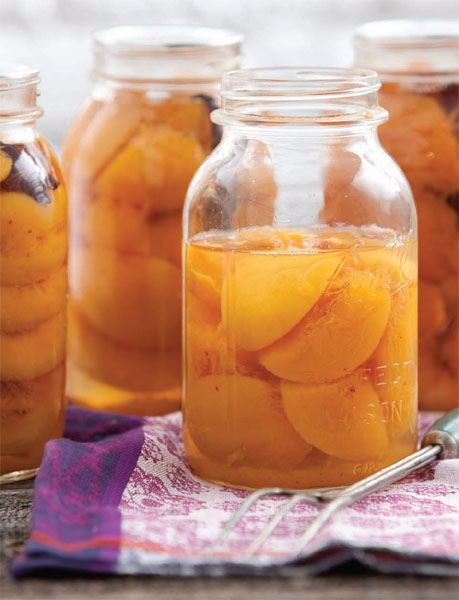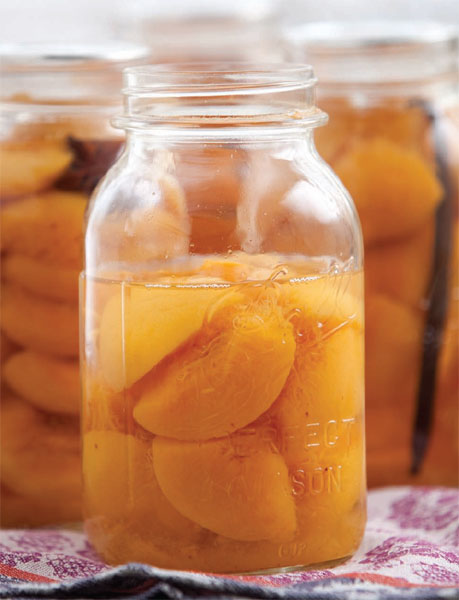Food in Jars (28 page)
Authors: Marisa McClellan

T
HIS SYRUP IS A GREAT WAY TO USE UP POST-HOLIDAY
cranberries (I can't be the only one who overbuys in anticipation of Thanksgiving and Christmas). The resulting syrup is quite thin, but has a sparkling, intense taste. I find that the thinner syrup works best for mixing into sparkling water and cocktails. However, if you want a thicker syrup, you can cook it down further until it turns sticky and similar in consistency to molasses.
1 pound/455 g cranberries
2 cups/400 g granulated sugar
Prepare a boiling water bath and 4 half-pint/250 ml jars according to the process on page 10. Place the lids in a small saucepan, cover them with water, and simmer over very low heat.
Combine the cranberries with 3 cups/720 ml water in a medium pot and bring to a boil. Reduce the heat and simmer until the berries burst, about 10 minutes.
Place a large fine-mesh sieve over a large bowl and strain the cranberries and their juice through the sieve. Let the cranberries drip undisturbed. Do your best to resist the urge to press the berry mash to help it release its liquid as this will result in a cloudy syrup.
Discard the solids in the sieve and return the strained juice to the pot. Add the sugar and bring to a boil, skimming any foam that appears on the top.
Remove the pan from the heat and pour the hot syrup into the prepared jars, leaving ½ inch/12 mm of headspace. Wipe the rims, apply the lids and rings, and process in a boiling water bath for 10 minutes (see
page 11
).

CANNED ORANGE AND GRAPEFRUIT SEGMENTS
BING CHERRIES IN RED WINE SYRUP

M
Y GRANDMA BUNNY WAS A SEASONAL EATER
long before it was cool. In her day, that's what everyone did. During the early years of her marriage, she lived on a farm in Virginia, not too far outside of Washington, D.C. It was there that she took up canning and adopted the habit of dishing out her home-canned fruit for dessert.
Truly, I think she was on to something. Canned fruit feels a bit more special that just grabbing a pear or an apple from the kitchen fruit bowl. Thanks to the heat it experiences during processing, the fruit takes on a mellow, silky texture. If you've taken the time to tuck a bit of vanilla bean, a hunk of cinnamon stick, or a whole star anise into the jar, it will be bright with flavor. And of course, the bit of sugar or honey in the syrup adds sweetness. If you ask me, canned fruit is nearly perfect for dessert.
This section contains just a sampling of options for canning fruit. Once you work your way through these recipes, you'll find that there's a whole fruity world out there waiting to be explored. I have kept the syrups fairly light because I like to maintain the idea that I'm eating something healthy. However, if you want to make a more indulgent batch, you can amp up the amount of sweetener in your syrup.

I
MADE A VERSION OF THESE WITH MANDARIN ORANGES
in the first year of my blog. I was so proud of them until I opened the third jar, about a month after canning. The fruit had turned bitter and I ended up throwing out all remaining jars. I later learned that if you don't remove the white membrane that divides each section of the fruit, sooner or later it will turn everything in the jar inedibly bitter. I didn't want to give up canning citrus entirely, so I switched to a blend of oranges and grapefruit because their larger size makes it easier to remove those pesky membranes. As a happy bonus, they also happen to taste terrific together.
3 pounds/1.4 kg navel oranges
3 pounds/1.4 kg ruby red grapefruit
1 cup/200 g granulated sugar
Prepare a boiling water bath and 4 regular-mouth 1-pint/500 ml jars according to the process on page 10. Place the lids in a small saucepan, cover them with water, and simmer over very low heat.
Segment the oranges and grapefruit according to the directions on page 000. Discard the peel and membrane.
Make the syrup by combining the sugar with 3 cups/720 ml water in a saucepan. Place over medium heat and stir until the sugar is dissolved. Bring to a gentle simmer and add the segmented citrus fruit. Heat the fruit until warmed through, about 4 to 5 minutes. Ladle the fruit and syrup into the prepared jars, leaving ½ inch/12 mm headspace. Gently tap the jars on a towel-lined countertop to help loosen any bubbles before using a wooden chopstick to dislodge any remaining bubbles and add additional syrup, if necessary.
Wipe the rims, apply the lids and rings, and process in a boiling water bath for 10 minutes (see
page 11
).


C
ANNED PEACHES GENERALLY GET A BAD RAP. THE
ones you buy at the grocery store typically manage to be both flavorless and slightly metallic. And often, home-canned peaches can look a little like a creature that has spent its life underwater. The thing is, however homely, a ripe peach canned in a slightly sweet syrup is just wonderful, particularly in March or April, when stone fruit is still months away. Add a slug of bourbon to each jar and prepare to be transported.
6 pounds/2.7 kg peaches (preferably freestone)
1 lemon
1½ cups/300 g granulated sugar
1 cup bourbon, divided
Prepare a boiling water bath and 4 regular-mouth 1-pint/500 ml jars according to the process on page 10. Place the lids in a small saucepan, cover them with water, and simmer over very low heat.
Bring a large pot of water to a boil. While it heats, cut the peaches in half and remove the pits. Fill a large bowl two-thirds full with ice-cold water. Cut the lemon in half and squeeze the juice into the water. This is where your peaches will go when they come out of the hot water bath. The cold water stops the cooking and the lemon helps prevent the fruit from browning.
Working in batches, add the peach halves to the boiling water and cook for 60 seconds. Immediately transfer the peaches to the bowl filled with ice-cold water. Before adding the next batch of peaches to the pot, make sure to give the water a chance to come back up to boiling between batches. If the water isn't hot enough, you will have a hard time removing the skin during peeling.
Once all the peaches have been blanched and they are cool enough to handle, remove the skins with your fingers and return the fruit to the lemon water.
Combine the sugar with 3 cups/720 ml water in a large saucepan. Place over medium heat and stir until the sugar is dissolved. Bring to a gentle simmer.
While the syrup heats, pack the peeled peach halves, cut-side down into the
prepared jars so that they overlap a bit. Use a wooden chopstick or narrow-head silicone spatula to help you layer them into the jars. It's best to use regular-mouth jars instead of wide-mouth jars in this instance, as the shoulders of the jars will help keep the peaches from floating out of the syrup after processing. Pack the peaches in as tightly as you can manage without damaging them.
When all the peaches are in the jars, ladle the hot syrup over them, leaving 1½ inches/4 cm headspace so that there's room for the bourbon. Add ¼ cup/60 ml bourbon to each jar. Use a wooden chopstick to remove any air bubbles and, if necessary, add additional syrup to the jars so that each has ½ inch/12 mm of headspace.
Wipe the rims, apply the lids and rings, and process in a boiling water bath for 25 minutes (see
page 11
).

